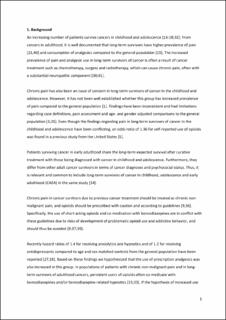| dc.contributor.author | Fredheim, Olav Magnus | |
| dc.contributor.author | Skurtveit, Svetlana | |
| dc.contributor.author | Loge, Jon Håvard | |
| dc.contributor.author | Sjøgren, Per | |
| dc.contributor.author | Handal, Marte | |
| dc.contributor.author | Hjellvik, Vidar | |
| dc.date.accessioned | 2021-03-03T11:44:39Z | |
| dc.date.available | 2021-03-03T11:44:39Z | |
| dc.date.created | 2020-02-07T11:39:58Z | |
| dc.date.issued | 2020 | |
| dc.identifier.citation | Pain. 2020, 161 (5), 1083-1091. | en_US |
| dc.identifier.issn | 0304-3959 | |
| dc.identifier.uri | https://hdl.handle.net/11250/2731389 | |
| dc.description.abstract | Increasing numbers survive cancers in childhood and adolescence. Long-term survivors of cancers in adulthood have increased prevalence of pain and consumption of analgesics. It is not established whether long-term survivors of cancers in childhood and adolescence also have an increased use of analgesics. However, based on increased use of antidepressants and anxiolytics in long-term survivors of cancers in childhood and adolescence, we hypothesized that this group also had increased use of analgesics. Based on data from the 2 nationwide registers, the Cancer Registry of Norway and the Norwegian Prescription Database, a cohort of 5585 (52% males) long-term survivors of cancers in childhood, adolescence, and early adult life was established. Age- and sex-adjusted comparisons were made to the general population. The age-adjusted one-year periodic prevalence of receiving prescriptions of opioids, benzodiazepines, and benzodiazepine-related hypnotics in the study population was increased by 20% to 50%, and the one-year periodic prevalence of receiving prescriptions of gabapentinoids was approximately increased 2-fold compared to the general population. For paracetamol and nonsteroidal anti-inflammatory drugs, no difference was found. For those survivors, who were persistent or high-dose users of opioids, comedication with high doses of benzodiazepines and/or benzodiazepine-related hypnotics was far more common than among persistent and high-dose opioid users in the general population. The high prevalence of gabapentinoids may indicate increased prevalence of neuropathic pain in this group. The high degree of comedication with benzodiazepines and/or benzodiazepine-related hypnotics in survivors on persistent and high-dose opioids might be an indication of problematic opioid use or addiction. | en_US |
| dc.language.iso | eng | en_US |
| dc.publisher | International Association for the Study of Pain | en_US |
| dc.title | Prescription of analgesics to long-term survivors of cancer in early adulthood, adolescence and childhood in Norway: a national cohort study | en_US |
| dc.type | Peer reviewed | en_US |
| dc.type | Journal article | en_US |
| dc.description.version | acceptedVersion | en_US |
| dc.source.pagenumber | 1083-1091 | en_US |
| dc.source.volume | 161 | en_US |
| dc.source.journal | Pain | en_US |
| dc.source.issue | 5 | en_US |
| dc.identifier.doi | 10.1097/j.pain.0000000000001800 | |
| dc.identifier.cristin | 1791950 | |
| dc.description.localcode | Locked until 1.5.2021 due to copyright restrictions. This is an [Accepted Manuscript] of an article . | en_US |
| cristin.ispublished | true | |
| cristin.fulltext | postprint | |
| cristin.qualitycode | 2 | |
